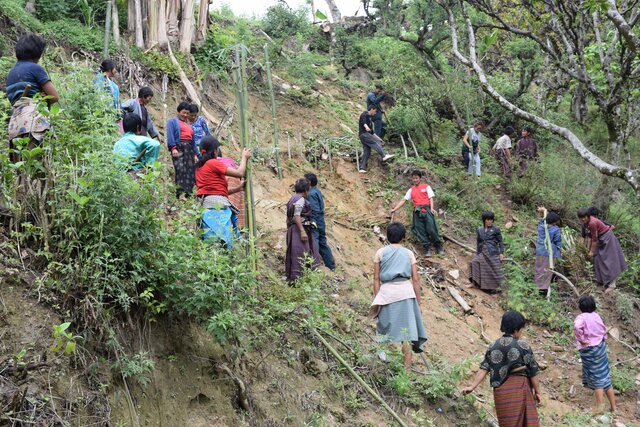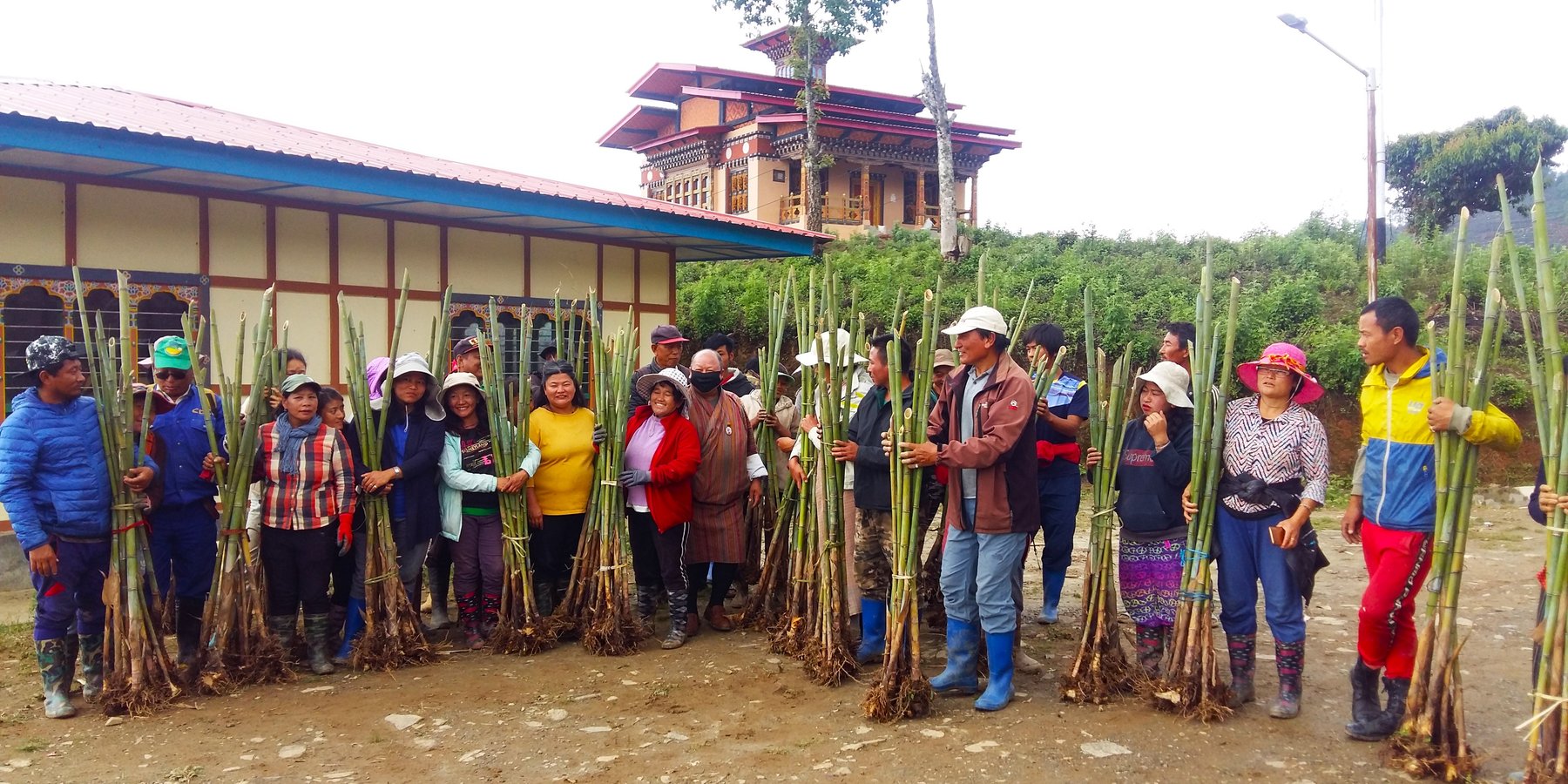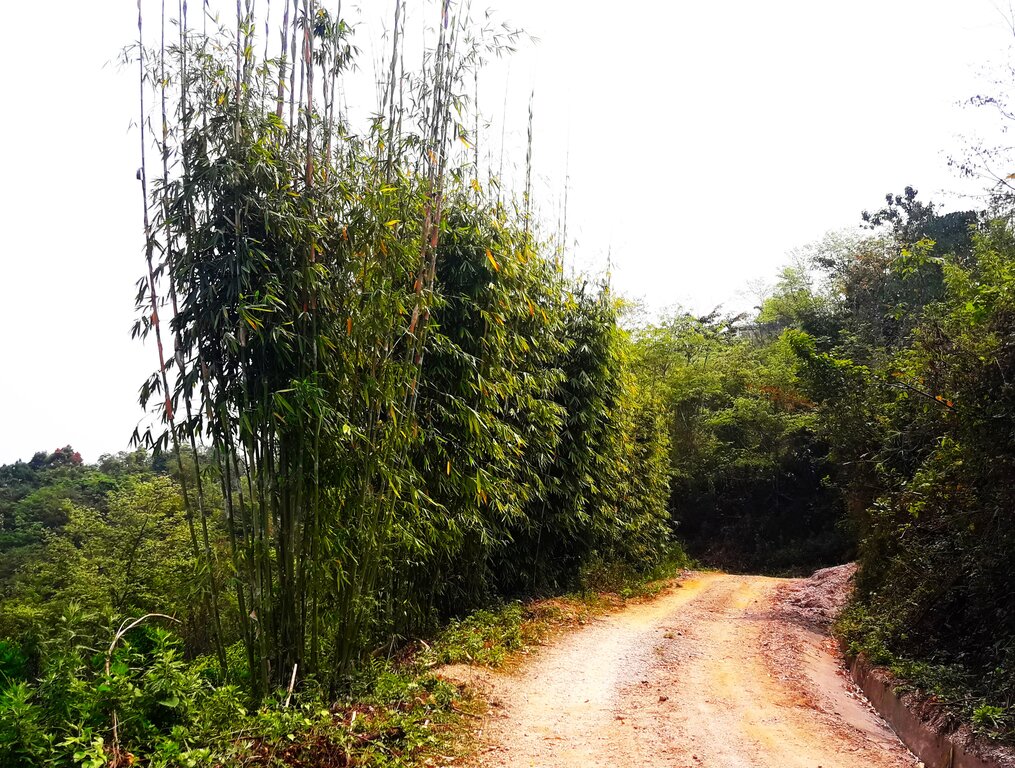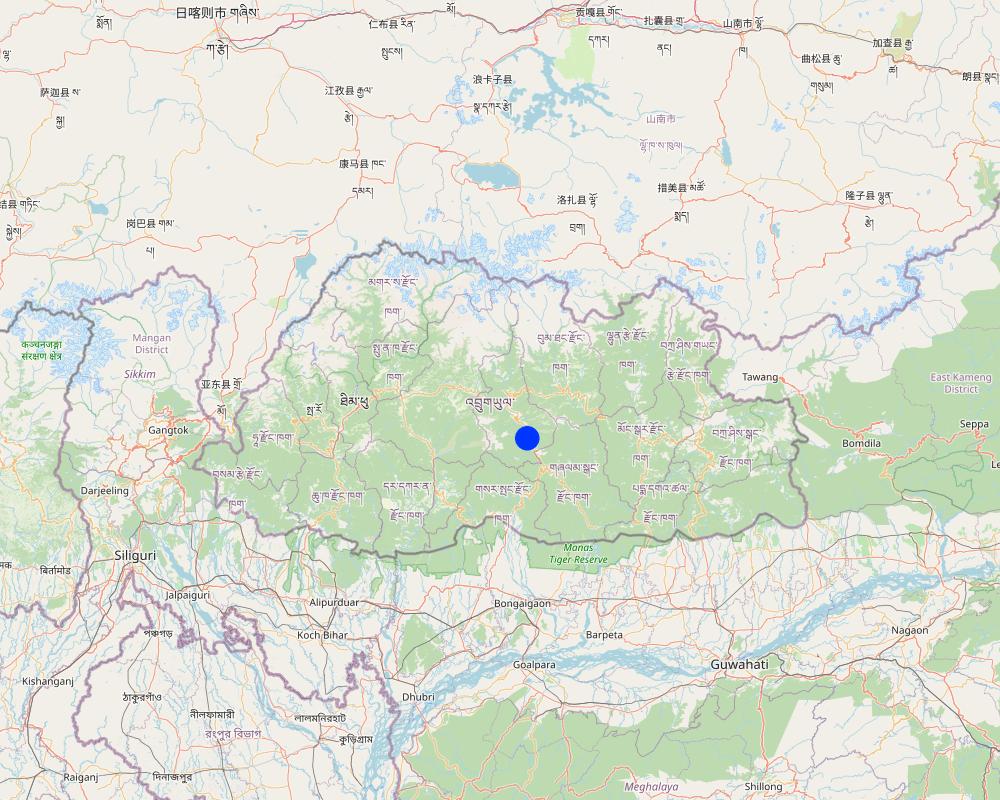Cane and Bamboo Plantation to Sustain Raw Materials [Bhutan]
- Creation:
- Update:
- Compiler: Tshering Yangzom
- Editor: Tashi Wangdi
- Reviewers: William Critchley, Rima Mekdaschi Studer
technologies_6859 - Bhutan
View sections
Expand all Collapse all1. General information
1.2 Contact details of resource persons and institutions involved in the assessment and documentation of the Technology
Key resource person(s)
land user:
Sonam
NA
Bhutan
land user:
Nagari
NA
Bhutan
land user:
Chencho
NA
Bhutan
land user:
Lethro
NA
Bhutan
1.3 Conditions regarding the use of data documented through WOCAT
The compiler and key resource person(s) accept the conditions regarding the use of data documented through WOCAT:
Yes
1.4 Declaration on sustainability of the described Technology
Is the Technology described here problematic with regard to land degradation, so that it cannot be declared a sustainable land management technology?
No
Comments:
Bamboo and cane plantations help prevent land degradation. Bamboo and cane have extensive root systems that help prevent erosion, stabilize soil, and reduce landslide risks. They are excellent for revegetation as they quickly establish themselves. Bamboo and cane plantation is a sustainable land management technology.
1.5 Reference to Questionnaire(s) on SLM Approaches (documented using WOCAT)

Community Forest Management Group [Bhutan]
The Community Forest Management Group (CFMG) functions with an aim to sustainably manage and utilize potential Non-Wood Forest Products (NWFP) such as cane and bamboo to diversify income sources. The Jangbi CFMG comprises three Monpa (indigenous) communities viz. Jangbi, Wangling and Phrumzur. The group's main mandates are to maintain raw …
- Compiler: Tshering Yangzom
2. Description of the SLM Technology
2.1 Short description of the Technology
Definition of the Technology:
Cane and bamboo plantations are managed by land users and indigenous communities to sustain these valuable raw materials for making handicraft items. Tsharzo (bamboo craft), is one of the main sources of income for land users. Tsharzo makes use of cane and bamboo to weave products such as backpacks, baskets (for winnowing, for carrying fodder, fruits, shoots, etc.), and mats. These plantations are effective in conserving land and water.
2.2 Detailed description of the Technology
Description:
Tsharzo (bamboo craft), is one of the main sources of income, besides agriculture, for the land users of the Monpa community of Jangbi, Wangling, and Phrumzur in Trongsa. Tsharzo makes use of cane (“rattan”: Calamus spp.) and bamboo to weave products such as orongbhazib (backpacks), lapchu (hand baskets), chungchu (baskets), bechab (winnowing baskets), tsew (baskets to carry fodder, fruits, shoots etc.) and pari (mats). The technology of maintaining bamboo and cane plantations has been adopted by the land users to ensure a sustainable harvest of natural raw materials and to maintain germplasm for bamboo and cane. This helps to uphold ancestral arts and crafts skills, and to improve livelihoods.
Jangbi chiwog has 59 households (HH). The land users are members of Monpa Selwai Yoezer Tshogpa, a Community Forest Management Group which was formed to sustainably manage bamboo and cane resources, to preserve and promote age-old cane and bamboo handicraft skills and increase household income. The group is one of the most successful in promoting Tsharzo in the country. The group was formed under the United Nations Development Programme (UNDP) on 14 April 2000, and officially came into play in 2007, upon drafting bylaws. The bylaws were revised after the need for further improvement in the year 2018. The group received initial support from UNDP and Bhutan Orchids, a non-governmental organization (NGO). The government has given a total of 45 acres (18 ha) of land to the land users of Jangbi Chiwog to plant bamboo and cane. Out of the total, 15 acres (6 ha) are collectively managed as a nursery. About 10 acres (4 ha) are managed by each village as a plantation. The land users have planted three varieties of bamboo on the land.
The benefits of the technology include the establishment of dedicated germplasm for bamboo and cane, sustainable harvest of natural raw materials, conservation and promotion of ancestral arts and crafts skills, social cohesion through group formation, and employment opportunities.
Bamboo and cane plantations play a great role in preventing soil degradation. Bamboo and cane have extensive root systems that help prevent erosion, stabilize soil, and reduce landslide risks. They are excellent for revegetation as they quickly establish themselves. Bamboo is also an efficient carbon sink, absorbing significant amounts of carbon dioxide from the atmosphere. This helps mitigate climate change by reducing greenhouse gas concentrations. Bamboo and cane provide habitats for various organisms thereby increasing biodiversity. Products made from bamboo and cane are biodegradable, minimizing any potential environmental impact.
2.3 Photos of the Technology
2.5 Country/ region/ locations where the Technology has been applied and which are covered by this assessment
Country:
Bhutan
Region/ State/ Province:
Jangbi, Wangling and Phrumzur villages under Jangbi Chiwog, Langthel gewog, Trongsa Dzongkhag
Specify the spread of the Technology:
- evenly spread over an area
If the Technology is evenly spread over an area, specify area covered (in km2):
18.2
Is/are the technology site(s) located in a permanently protected area?
Yes
If yes, specify:
The area falls under Jigme Singye Wangchuk National Park (JSWNP), Department of Forests and Park Services. The park is the third largest protected area in Bhutan, harbouring several globally threatened wildlife species.
Map
×2.6 Date of implementation
Indicate year of implementation:
2000
2.7 Introduction of the Technology
Specify how the Technology was introduced:
- through land users' innovation
- through projects/ external interventions
Comments (type of project, etc.):
The bamboo and cane plantation began through the formation of the group, Monpa Selwai Yoezer Tshogpa, by the three villages of Jangbi chiwog in 2000, with funds from UNDP and Bhutan Orchids.
3. Classification of the SLM Technology
3.1 Main purpose(s) of the Technology
- conserve ecosystem
- create beneficial economic impact
- create beneficial social impact
3.2 Current land use type(s) where the Technology is applied
Land use mixed within the same land unit:
No
Comments:
The land use is not mixed. The government has given a total of 45 acres of land to the land users of Jangbi Chiwog to plant bamboo and cane. Out of the 45 acres, 15 acres of land are collectively managed by all the land users of Jangbi chiwog for nursery raising. About 10 acres is managed by each village under the Chiwog for plantation activities. The land users planted three varieties of bamboo on the land. The land use is solely for cane and bamboo plantations.
3.3 Has land use changed due to the implementation of the Technology?
Has land use changed due to the implementation of the Technology?
- No (Continue with question 3.4)
3.4 Water supply
Water supply for the land on which the Technology is applied:
- mixed rainfed-irrigated
3.5 SLM group to which the Technology belongs
- natural and semi-natural forest management
- forest plantation management
3.6 SLM measures comprising the Technology

vegetative measures
- V1: Tree and shrub cover

structural measures
- S6: Walls, barriers, palisades, fences
Comments:
The technology can be categorized under vegetative measure since it involves plantations, and under structure measure as it involves fencing of the designated area.
3.7 Main types of land degradation addressed by the Technology

soil erosion by water
- Wt: loss of topsoil/ surface erosion
- Wg: gully erosion/ gullying
- Wm: mass movements/ landslides

soil erosion by wind
- Et: loss of topsoil

biological degradation
- Bc: reduction of vegetation cover
- Bq: quantity/ biomass decline
3.8 Prevention, reduction, or restoration of land degradation
Specify the goal of the Technology with regard to land degradation:
- prevent land degradation
- reduce land degradation
Comments:
Bamboo and cane plantations play a great role in preventing soil degradation. Bamboo and cane have extensive root systems that help prevent erosion, stabilize soil, and reduce landslide risks. They are excellent for revegetation as they quickly establish themselves.
4. Technical specifications, implementation activities, inputs, and costs
4.1 Technical drawing of the Technology
Technical specifications (related to technical drawing):
The bamboos thriving in the wild are documented in the community. They are an important source of raw materials for producing bamboo products.
Author:
Tshering Yangzom
4.2 General information regarding the calculation of inputs and costs
Specify how costs and inputs were calculated:
- per Technology area
Indicate size and area unit:
45 acres
If using a local area unit, indicate conversion factor to one hectare (e.g. 1 ha = 2.47 acres): 1 ha =:
45 acres = 18.2 ha
other/ national currency (specify):
Nu.
If relevant, indicate exchange rate from USD to local currency (e.g. 1 USD = 79.9 Brazilian Real): 1 USD =:
82.0
4.3 Establishment activities
| Activity | Timing (season) | |
|---|---|---|
| 1. | Attempted to commercialize bamboo and cane products through market exploration (contract) by a few households. | 2000 |
| 2. | Gewog and the Forest Office collaboratively explored funds to help the communities. | 2000 |
| 3. | Funds sourced from UNDP. The land users were sensitized. | 2000 (summer-during paddy season) |
| 4. | The land users were trained on plantations and product development. | 2000 |
| 5. | Land users (12 of them) were taken on an exposure tour to India. | 2000 |
4.4 Costs and inputs needed for establishment
If you are unable to break down the costs in the table above, give an estimation of the total costs of establishing the Technology:
2200000.0
If land user bore less than 100% of costs, indicate who covered the remaining costs:
The UNDP supported with the funds. Later, Bhutan Orchids too supported with Nu. 800,000.
Comments:
The total cost of establishing the technology on 18.2 ha of land was Nu. 2200000 (around USD 26830). So the costs incurred per hectare was about USD 1475.
4.5 Maintenance/ recurrent activities
Comments:
Despite minor additional plantations by the communities until 2010, no major maintenance and plantations were carried out due to fund shortages.
4.6 Costs and inputs needed for maintenance/ recurrent activities (per year)
If you are unable to break down the costs in the table above, give an estimation of the total costs of maintaining the Technology:
20000.0
If land user bore less than 100% of costs, indicate who covered the remaining costs:
The land users bore the cost (the estimated cost of maintaining the technology is Nu. 20000 [around USD 244)
Comments:
Despite minor additional plantations by the communities until 2010, no major maintenance and plantations were carried out due to fund shortages.
5. Natural and human environment
5.1 Climate
Annual rainfall
- < 250 mm
- 251-500 mm
- 501-750 mm
- 751-1,000 mm
- 1,001-1,500 mm
- 1,501-2,000 mm
- 2,001-3,000 mm
- 3,001-4,000 mm
- > 4,000 mm
Specifications/ comments on rainfall:
The rain estimate has been derived based on the agro-ecological zone (AEZ) the area falls under. Bhutan is divided into six AEZs (source: https://www.fao.org/3/ad103e/AD103E02.htm).
Agro-climatic zone
- sub-humid
The site is about 1500 masl. It falls under Dry-Subtropical Zone. Bhutan has six AEZs. The wet sub-tropical zone is from 150 to 600 m, followed by the humid sub-tropical zone from 600 to 1,200 m. The dry sub-tropical zone starts at 1,200 m and extends to 1,800 m, followed by the warm temperate zone, which reaches 2,600 m. The cool temperate zone lies between 2,600 and 3,600 m and, finally, the alpine zone between 3,600 m and 4,600 m.
https://www.fao.org/3/ad103e/AD103E02.htm
5.2 Topography
Slopes on average:
- flat (0-2%)
- gentle (3-5%)
- moderate (6-10%)
- rolling (11-15%)
- hilly (16-30%)
- steep (31-60%)
- very steep (>60%)
Landforms:
- plateau/plains
- ridges
- mountain slopes
- hill slopes
- footslopes
- valley floors
Altitudinal zone:
- 0-100 m a.s.l.
- 101-500 m a.s.l.
- 501-1,000 m a.s.l.
- 1,001-1,500 m a.s.l.
- 1,501-2,000 m a.s.l.
- 2,001-2,500 m a.s.l.
- 2,501-3,000 m a.s.l.
- 3,001-4,000 m a.s.l.
- > 4,000 m a.s.l.
Indicate if the Technology is specifically applied in:
- not relevant
Comments and further specifications on topography:
The field slope ranges from 14% to 30%.
5.3 Soils
Soil depth on average:
- very shallow (0-20 cm)
- shallow (21-50 cm)
- moderately deep (51-80 cm)
- deep (81-120 cm)
- very deep (> 120 cm)
Soil texture (topsoil):
- medium (loamy, silty)
5.4 Water availability and quality
Availability of surface water:
medium
Water quality (untreated):
good drinking water
Water quality refers to:
surface water
Is water salinity a problem?
No
Is flooding of the area occurring?
No
5.5 Biodiversity
Species diversity:
- high
Habitat diversity:
- high
Comments and further specifications on biodiversity:
High vegetation coverage and evident agroforestry indicate high species and habitat diversity.
5.6 Characteristics of land users applying the Technology
Sedentary or nomadic:
- Sedentary
Market orientation of production system:
- commercial/ market
Off-farm income:
- 10-50% of all income
Relative level of wealth:
- poor
Individuals or groups:
- individual/ household
- groups/ community
Level of mechanization:
- manual work
- animal traction
Gender:
- women
- men
Age of land users:
- youth
- middle-aged
5.7 Average area of land used by land users applying the Technology
- < 0.5 ha
- 0.5-1 ha
- 1-2 ha
- 2-5 ha
- 5-15 ha
- 15-50 ha
- 50-100 ha
- 100-500 ha
- 500-1,000 ha
- 1,000-10,000 ha
- > 10,000 ha
Is this considered small-, medium- or large-scale (referring to local context)?
- large-scale
Comments:
The average land holding at the national level is 3 acres (1.2 ha). The average land holding of the land users in the community ranges from 5 to 8 acres, falling under large scale in the local context.
In the local context:
3 acres (1.2 ha) = medium scale
> 3 acres = large scale
<3 acres = small-scale
5.8 Land ownership, land use rights, and water use rights
- Family land
Land use rights:
- individual
Water use rights:
- communal (organized)
Are land use rights based on a traditional legal system?
Yes
Specify:
The land use rights in Bhutan are based on a traditional legal system guided by formal land acts and land rules and regulations.
5.9 Access to services and infrastructure
health:
- poor
- moderate
- good
education:
- poor
- moderate
- good
technical assistance:
- poor
- moderate
- good
employment (e.g. off-farm):
- poor
- moderate
- good
markets:
- poor
- moderate
- good
energy:
- poor
- moderate
- good
roads and transport:
- poor
- moderate
- good
drinking water and sanitation:
- poor
- moderate
- good
financial services:
- poor
- moderate
- good
6. Impacts and concluding statements
6.1 On-site impacts the Technology has shown
Socio-economic impacts
Production
non-wood forest production
Quantity before SLM:
50 - 60 products in a year
Quantity after SLM:
10 - 15 products in a year
Comments/ specify:
The non-wood forest production has increased due to sustainable plantation, but the number of products developed using the raw materials has decreased. But again, the income has increased. In the earlier years, a household would earn about Nu.10000 by selling 50 - 60 products, whereas a household now earns a minimum of Nu. 25000 by selling 10 - 15 products due to higher prices of the products.
production area
Quantity after SLM:
18.2 ha
Comments/ specify:
With the initiation of bamboo and cane germplasm, the production area has increased and the source of raw materials for the community is sustained. Before the land users were given 18.2 ha by the government, the land users collected cane and bamboo from the forest to make products.
land management
Comments/ specify:
The bamboo and cane plantations have prevented soil erosion and stabilized the lands.
Income and costs
diversity of income sources
Comments/ specify:
The income earned from products sold in the market adds to the annual income of the family.
Socio-cultural impacts
food security/ self-sufficiency
Comments/ specify:
The higher annual income generation from the sale of bamboo and cane products has assured food security in some ways.
health situation
Comments/ specify:
Better income and diet have resulted in better health.
SLM/ land degradation knowledge
Comments/ specify:
The role of plantations in mitigating land degradation is well-instilled in the land users. They now even carry out bamboo plantations along the peripheries of newly constructed roads to stabilize the soil faster.
conflict mitigation
Comments/ specify:
There is equity in the harvest of raw materials.
situation of socially and economically disadvantaged groups
Comments/ specify:
The land users have been able to improve their livelihood through sustainable management of bamboo and cane and the sale of the finished products.
Ecological impacts
Biodiversity: vegetation, animals
Vegetation cover
Comments/ specify:
The vegetation cover has increased due to the plantation.
biomass/ above ground C
Comments/ specify:
The biomass has increased due to the increase in vegetation cover.
6.2 Off-site impacts the Technology has shown
Specify assessment of off-site impacts (measurements):
According to the land users, no off-site impacts have been there for now.
6.3 Exposure and sensitivity of the Technology to gradual climate change and climate-related extremes/ disasters (as perceived by land users)
Gradual climate change
Gradual climate change
| Season | increase or decrease | How does the Technology cope with it? | |
|---|---|---|---|
| annual temperature | increase | very well |
Climate-related extremes (disasters)
Meteorological disasters
| How does the Technology cope with it? | |
|---|---|
| local rainstorm | very well |
| local thunderstorm | very well |
| local hailstorm | very well |
| local windstorm | very well |
Climatological disasters
| How does the Technology cope with it? | |
|---|---|
| forest fire | not well at all |
Hydrological disasters
| How does the Technology cope with it? | |
|---|---|
| landslide | very well |
Comments:
The respondents pointed out that the current rainfall pattern has changed compared to the past 10 - 15 years though there is no change in quantity. Before, there used to be steady and enough rain. Now, the dry days continue for quite a long time and when rain comes, it's abrupt and intense.
6.4 Cost-benefit analysis
How do the benefits compare with the establishment costs (from land users’ perspective)?
Short-term returns:
positive
Long-term returns:
positive
How do the benefits compare with the maintenance/ recurrent costs (from land users' perspective)?
Short-term returns:
very positive
Long-term returns:
very positive
6.5 Adoption of the Technology
- > 50%
If available, quantify (no. of households and/ or area covered):
59 HH are part of Monpa Selwai Yoezer Tshogpa
Of all those who have adopted the Technology, how many did so spontaneously, i.e. without receiving any material incentives/ payments?
- 0-10%
Comments:
UNDP and Bhutan Orchids have fully funded cane and bamboo plantation activities.
6.6 Adaptation
Has the Technology been modified recently to adapt to changing conditions?
No
6.7 Strengths/ advantages/ opportunities of the Technology
| Strengths/ advantages/ opportunities in the land user’s view |
|---|
| Preserve and promote ancestral arts and crafts skills. |
| Maintain germplasm for bamboo and cane. The raw materials for future use are assured due to the establishment of a 45-acre germplasm. |
| Generate income through the sale of bamboo and cane products. |
| Sustainable harvest of natural raw materials |
| Strengths/ advantages/ opportunities in the compiler’s or other key resource person’s view |
|---|
| Higher vegetation cover. |
| Prevent land degradation (bamboo and cane have extensive root systems that help prevent erosion, stabilize soil, and reduce landslide risks). |
| Sustainable utilization of forest resources (bamboo and cane). |
| Diversify income sources of the land users. |
| Social cohesion through collaboration and coordination among the land users. |
6.8 Weaknesses/ disadvantages/ risks of the Technology and ways of overcoming them
| Weaknesses/ disadvantages/ risks in the land user’s view | How can they be overcome? |
|---|---|
| The identified germplasm area lacks suitable places for convenient plantations. The majority of the area is rugged terrain and steep. | Exclude the steep and rugged terrains. Explore and identify suitable and more convenient areas for plantation. |
| The wooden fencing poles surrounding the germplasm area are not durable (cannot withstand barbed wires for longer periods). | Replace the wooden fencing poles with steel posts or other durable materials. |
| No funds to scale up. For instance, the canes lost in the 2017 forest fire have not been re-generated like bamboo. | Additional funds are to be sought to scale up the plantation programs. |
| Weaknesses/ disadvantages/ risks in the compiler’s or other key resource person’s view | How can they be overcome? |
|---|---|
| No funds to scale up. | Provision of funds by relevant stakeholders. |
| Risk of fire. | The Department of Forests and Park Services had initiated Interagency Forest Fire Coordination Group (IFFCG) at Dzongkhag and Gewog level to mitigate fire with involvement of Dzongkhag, Gewogs and relevant agencies. The IFFCG is headed by Dasho Dzongda and the Dzongkhag disaster management committee in coordination with relevant agency are responsible for mitigation and preventing the fire and provide necessary support to the affected individual or community. Several awareness programs and hands on training on fire mitigation and prevention was also provided to the communities by the Department of Forests and Park Services. |
7. References and links
7.1 Methods/ sources of information
- field visits, field surveys
Four
- interviews with land users
Four
When were the data compiled (in the field)?
17/07/2023
7.3 Links to relevant online information
Title/ description:
Bamboo and Cane Vulnerability and Income Generation in the Rural Household Subsistence Economy of Bjoka, Zhemgang, Bhutan
URL:
https://www.researchgate.net/publication/232663730_Bamboo_and_Cane_Vulnerability_and_Income_Generation_in_the_Rural_Household_Subsistence_Economy_of_Bjoka_Zhemgang_Bhutan
Title/ description:
Bamboo/cane plantation to sustain Monpa livelihood
URL:
https://kuenselonline.com/bamboocane-plantation-to-sustain-monpa-livelihood/
Title/ description:
Monpas of Bhutan: A Study of Tribal Survival and Development Responses
URL:
https://architales.org/wp-content/uploads/2020/06/03-Raghubir-CHANDp25-37.pdf
Links and modules
Expand all Collapse allLinks

Community Forest Management Group [Bhutan]
The Community Forest Management Group (CFMG) functions with an aim to sustainably manage and utilize potential Non-Wood Forest Products (NWFP) such as cane and bamboo to diversify income sources. The Jangbi CFMG comprises three Monpa (indigenous) communities viz. Jangbi, Wangling and Phrumzur. The group's main mandates are to maintain raw …
- Compiler: Tshering Yangzom
Modules
No modules






